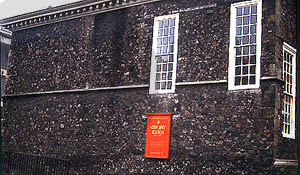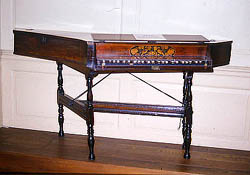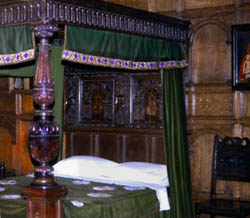Bristol's Red Lodge and Its Elizabethan Knot Garden
by Yvonne Cuthbertson
 The Red Lodge with its magnificent, walled
Elizabethan knot garden is a splendid example of a 16th century
mansion. Situated in Park Row, Bristol in the County of Somerset,
it was built around 1590 by Sir John Younge, a wealthy Bristolian
merchant, who was knighted by Queen Elizabeth 1 in 1574. The
house, although considerably altered externally, contains some
beautifully appointed rooms with rich oak panelling, elaborately
carved chimney-pieces, panelled plaster ceilings with pendants,
and fine examples of Tudor furniture. On the first floor, is the
famous Oak Room, richly panelled and exquisitely carved, which
can be reached by a fine eighteenth century staircase with
barley-sugar balusters. The Red Lodge with its magnificent, walled
Elizabethan knot garden is a splendid example of a 16th century
mansion. Situated in Park Row, Bristol in the County of Somerset,
it was built around 1590 by Sir John Younge, a wealthy Bristolian
merchant, who was knighted by Queen Elizabeth 1 in 1574. The
house, although considerably altered externally, contains some
beautifully appointed rooms with rich oak panelling, elaborately
carved chimney-pieces, panelled plaster ceilings with pendants,
and fine examples of Tudor furniture. On the first floor, is the
famous Oak Room, richly panelled and exquisitely carved, which
can be reached by a fine eighteenth century staircase with
barley-sugar balusters.
Below the Lodge, and entered by a door under the stairs, are some
of the cells thought to belong to the Carmelite Friary, the house
and grounds of which were bought by Bristol Corporation upon the
dissolution of the monasteries in 1538. These were afterwards
sold to Sir John Younge who built his Great House on the site
circa 1570, later adding the White Lodge, just to the east, and
the Red Lodge, a short distance up the hill. Both lodges,
incidentally, were originally built as an adjunct to the main
house to be used for entertainments and the accommodation of
visitors and guests.
Unfortunately, Sir John died in 1589 before the Red Lodge had
been completed, and his nineteen-year-old son, Robert, inherited
the estate. Robert Younge, however, was not like his father; his
lifestyle was dissolute and resulted in him mortgaging the
property in the 1590s and being forced to sell it in 1603. During
the following two hundred and fifty years, the house was occupied
by Bristol merchants and their families and suffered regular
changes in ownership. The fabric of the building was considerably
altered by John and Mary Henley in the early eighteenth century
and, during the 1780s/90s, William Trotman, a woollen draper and
entrepreneur, purchased the Lodge and proceeded to build houses
on the orchards and gardens, to sell off land as building plots,
and finally to let the property.
 In 1854, the
Red Lodge was bought by Lady Byron, widow of the poet, to be used
as the first girls' reformatory school in this country. She
presented it to Mary Carpenter, one of the originators of the
Reformatory system for poor girls and a pioneer of philanthropic
work. The daughter of a Unitarian minister and schoolmaster, Mary
Carpenter had worked with some of the poorest, most deprived
children in Bristol, and, by 1852, she had already established a
reformatory school for girls in nearby Kingswood, in a house that
had once been used by John Wesley. In 1854, the
Red Lodge was bought by Lady Byron, widow of the poet, to be used
as the first girls' reformatory school in this country. She
presented it to Mary Carpenter, one of the originators of the
Reformatory system for poor girls and a pioneer of philanthropic
work. The daughter of a Unitarian minister and schoolmaster, Mary
Carpenter had worked with some of the poorest, most deprived
children in Bristol, and, by 1852, she had already established a
reformatory school for girls in nearby Kingswood, in a house that
had once been used by John Wesley.
Mary's eldest brother, William Benjamin, had been tutor for a
time in the household of Lord Lovelace, Byron's son-in-law, and a
friendship had been forged between the Byrons and the Carpenter
family. Her work with these girls, details of which can be found
in the Exhibition Room, won her national acclaim. After her death
in 1877, a plaque in her honour was erected in the Red Lodge as
well as a bust of her in Bristol Cathedral. Sadly, as new methods
of dealing with young offenders evolved, the reformatory school
slipped from the public's gaze, and eventually closed in 1917,
leaving the Red Lodge once again up for sale.
Details of the sale were brought to the attention of Alderman
James Fuller Eberle who, in order to save the building from being
stripped of its assets, immediately organised a public appeal.
With the aid of local benefactors such as Sir George Wills, the
house was bought, renovated and presented to the City of Bristol.
The City then leased it to the Bristol Savages, a club for
artists and art lovers, who moved in upon the completion of
renovations in 1920. The architect C.F.W. Dening was commissioned
to carry out the restoration programme, and it was he who later
built a meeting room in the garden for the club, known as 'the
Wigwam', and where the Bristol Savages continue to hold their
meetings.
Looking at the Red Lodge today, it is hard to believe that it
once stood in extensive grounds of walled gardens and orchards.
Nowadays, all that remains is a small square of garden surrounded
by a high wall, with the entrance to the house at the back of the
property bordering on to a busy main road. The garden has,
however, with the help of public funding, been redesigned as a
knot garden and filled with the herbs and plants of Elizabethan
England, all of which were originally cultivated for their
usefulness rather than for their aesthetic value.

The Elizabethan herb or knot garden was popular during an age
when sweet-scented herbs took pride of place in every garden.
English knot gardens were first recorded in the fifthteenth
century and were one of the most successful of herb garden
designs, with horticultural books of the time giving numerous
illustrations for their cultivation.
Usually contained within a square or rectangular shaped plot,
each knot pattern had to be precisely outlined by low, clipped
hedges of scented evergreen herbs. Favourite hedging herbs of the
time were hyssop, santolina, thyme and marjoram; box was also
very popular. Often, aromatic hedges of rosemary and lavender
were planted for drying linen and the clippings were used for
strewing or distilling into oils or waters. Paths were made of
raked gravel, bricks or small coloured pebbles.
The actual designs themselves were often formed from family
crests, heraldic devices or even the entwined initials of the
lord and lady of the manor house. The pattern for the garden at
the Red Lodge has been taken from a bedroom ceiling, and the
trellis that encloses the knot of box hedges is made to a
seventeenth century design.
 The house itself retains many of its original
features, with some of the rooms beautifully panelled in oak. It
was built at a time when nouveau riche merchants were beginning
to demand an improved standard of comfort and starting to live in
princely style, and, while rooms opened one out of the other,
with no connecting corridors, there was a growing number of
separate rooms in all houses. Fireplaces with chimneys were
becoming commonplace, with mantels designed in very elaborate
styles, the Red Lodge chimneypiece in the Great Oak Room being a
fine example of local craftsmanship. The house itself retains many of its original
features, with some of the rooms beautifully panelled in oak. It
was built at a time when nouveau riche merchants were beginning
to demand an improved standard of comfort and starting to live in
princely style, and, while rooms opened one out of the other,
with no connecting corridors, there was a growing number of
separate rooms in all houses. Fireplaces with chimneys were
becoming commonplace, with mantels designed in very elaborate
styles, the Red Lodge chimneypiece in the Great Oak Room being a
fine example of local craftsmanship.
Among the wealthy, rich, elaborately carved furniture was much in
demand. Heavy oak linen chests which doubled as seats and
intricately carved four-poster beds were highly prized as
heirlooms to be handed down from generation to generation. One
such four-poster bed may be found in the Bedroom of the Red
Lodge, complete with embroidered hangings and bedding, the panels
on the green velvet hangings being copied from Mary Queen of
Scots' cipher work in fine tent stitch that can be seen on the
famous hangings of Oxburgh Hall in Norfolk.
Not surprisingly, the Elizabethans were very fond of lavish and
expensive bed hangings, the bedchamber being one of the rooms
designated at that time for receiving guests. Naturally,
therefore, it was important to wealthy householders that the
bedchamber should be sumptuously decorated in order to impress
visitors. Often, elaborately worked embroideries such as valances
were displayed, many of them worked in tent stitch with a few
simulated pearls embroidered in raised stitches to add
texture.
Since 1948, the Red Lodge and its garden has been in the care of
the City of Bristol Museum and Art Gallery and is open to the
public from Tuesday to Saturday: 10am - 12pm booked parties only,
1pm - 5pm general visitors, and is a popular tourist attraction.
The tour of the house starts upstairs in the Great Oak Room,
progressing to the Small Oak Room, which leads from it. The
visitor then moves into the Bedroom, on through the Exhibition
Room, which contains documents and artefacts of the history of
the Red Lodge and its inhabitants, and then across the landing to
the Print Room where seventeenth century French portraits are
housed. The tourist then descends the staircase on one wall of
which hangs portraits of John Henley and his wife, Mary Fane, and
enters the Reception Room which contains few Elizabethan features
due to the alterations made by the Henleys, afterwards proceeding
into the Parlour which, again, is decorated and furnished in
largely Georgian style. The tour ends in the New Oak Room, access
to which is gained by returning through the Reception Room and
turning left from the hall. This room has also been altered but,
this time, during the nineteenth century, with its oak panelling
coming from St Michael's Rectory in Bristol.
With the accession of Queen Elizabeth 1 to the English throne in
1558, came a long period of growth, prosperity and settled social
and cultural conditions. It was a time of stability and
consolidation when the aristocracy, affluent landowners and the
rising middle classes had the time and the money to spend on
decorating both their persons and their houses, and making costly
and elaborate gardens of which they were extremely proud. The Red
Lodge is one such West Country house that has fortunately been
preserved, and both it and its garden are well worth a visit,
particularly now that most of Bristol's late sixteenth century
buildings have gone, taking in their wake a visual reminder of
one of the greatest ages of excitement, adventure and personal
endeavour that Great Britain has ever known.
Visiting the Red Lodge
Now furnished as a family home, this Elizabethan lodge is hidden
amidst the bustle of modern Bristol. And, if you are planning a
stay in the West Country of England, it is well worth a visit.
The entrance to the lodge appears uninviting because it is at the
rear of the building, with the true façade facing
downhill. Once inside, however, you will be given a fascinating
glimpse into life in Elizabethan Bristol. You will also be amazed
by its south-facing walled garden, an excellent example of a
re-created Elizabethan-style knot garden with herbaceous borders.
All the plants grown here could have been found in English
gardens by 1630. It's a garden that offers tranquillity, a place
to sit and wonder.
The Lodge is quite close to Bristol City
centre, so, should you decide to go there, you can take a bus
from the centre of Bristol, or hire a taxi.
More Information:
We regret that we no longer have the resources to maintain up-to-date links and/or hours and pricing details for the various sites and attractions listed on this website. For more information about the location(s) listed above, please use your favorite search engine or visit Wikipedia.
Yvonne Cuthbertson lives with her family in
the County of Wiltshire. She has, during the past few years,
freelanced for a variety of magazines both at home and abroad,
having previously been employed as a Headteacher. She is the
holder of the Royal Horticultural Society's General Certificate
(RHS). Her first book, Women Gardeners: A History, was published
in 1998 by Arden Press in Colarado, and her second book,
Beginners' Guide to Herb Gardening, by The Guild of Master
Craftsman Publications in Sussex, England in 2001. Her interests
include: photography, gardening, history, alternative medicine,
wildlife and conservation and education and management.
Article and photos © 2006 Yvonne
Cuthbertson
|
